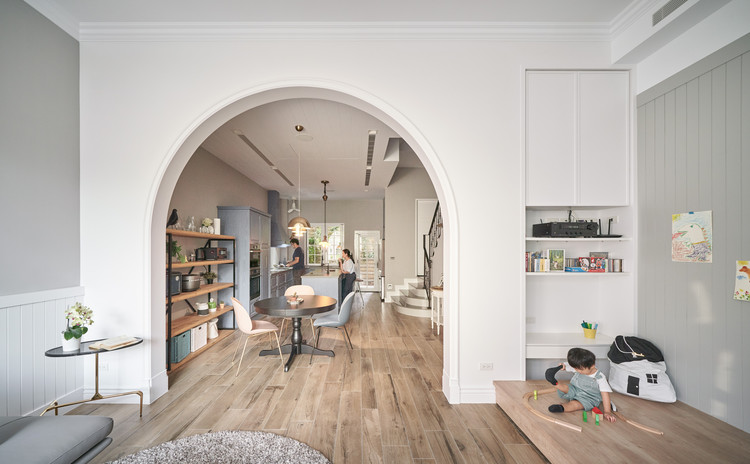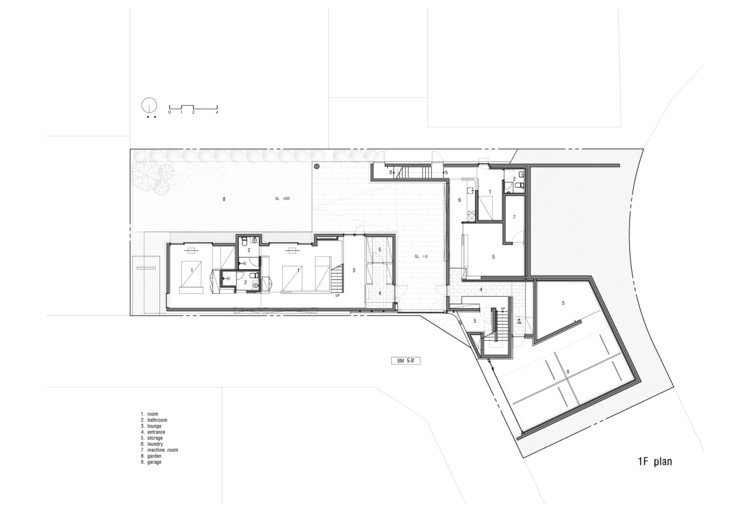AD Classics Limoges Concert Hall Bernard Tschumi Architects
2015-05-11 06:00
虽然音乐厅的概念根源可以追溯到早期的项目,建筑师的参与是从2003年在当地政府的比赛中获得第一名开始的。在鲁昂,他提出了一个方案,其中建筑的生成中心和它的大部分集中在一个圆形的,圆形的表演空间。一个单一的、连续的门厅从这个形状集中出现,围绕着大厅一侧的轮廓,无论是在平面上还是在其截面的柔和曲线上。这个简单的图表,在其近乎纯洁的优雅,是轻微的打破在外部外观的一个小入口突出和一个有点笨拙的后台附属物横穿它。
While the concert hall’s conceptual roots can be traced to earlier projects, the architect’s involvement at Limoges began when he won first place in the local government’s competition in 2003. As in Rouen, he proposed a scheme in which the generative center of the building and the bulk of its massing are located in a circular, amphitheatrical performance space. A single, continuous foyer emerges concentrically from this shape, wrapping itself around the contours of one side of the hall, both in plan and in the gentle curve of its section. This simple diagram, elegant in its near-purity, is broken slightly by a small entrance protrusion in the outer façade and a somewhat clumsy backstage appendage diametrically across from it.
Courtesy of Bernard Tschumi Architects
Tschumi对围护结构的概念探索为设计的同心性提供了依据,这是第二层围护结构,它在礼堂的质量和外部世界的曝光之间创造了一个间隙空间。就像他在格罗宁根和图尔孔的项目一样,“中间”的作用是通过形式、材料、照明、纹理、膨胀甚至温度的渐变,在离散环境之间进行过渡。薄的外壳,由细长的木肋骨和半透明的聚碳酸酯面板组成,与内部外壳的像素化坚固性形成鲜明对比。内层,最突出的经验是大厅的悬垂进入门厅,将下腹的锐角推到由外信封的柔和曲线所创造的空间中。这两个系统似乎在相互之间延伸,而不是直接在对抗中相遇,而是在空间上进行戏剧性的对话,这说明了它们的独立作用。
Informing the concentricity of the design is Tschumi’s conceptual exploration of the envelope, a second layer of enclosure that creates an interstitial space between the mass of the auditorium and the exposure of the outside world. Like his projects at Groningen and Tourcoing, the “in-between” serves to mediate the transition between discrete conditions through gradual transformations in form, material, lighting, texture, expansiveness, and even temperature. The thin outer shell, made of slender wooden ribs and translucent polycarbonate panels, contrasts with the pixilated solidity of the inner enclosure. The inner layer, most prominently experienced as the overhang of the auditorium into the foyer, pushes the sharp angle of its underbelly into the space created by the outer envelope’s gentle curve. The two systems seem to extend gesturally past one another without ever directly meeting in confrontation, instead engaging each other in a dramatic dialogue of spatial give-and-take that illustrates their independent roles.
Digital section model demonstrating structural systems and the multiple layers of enclosure. Image Courtesy of Bernard Tschumi Architects
数字剖面模型演示结构体系和多层外壳。托米建筑师的形象礼貌
Courtesy of Bernard Tschumi Architects
向量,与Tschumi的理论姿态中的信封有关,负责激活建筑物的多层围护结构所创造的空间。Tschumi没有将循环空间概念化为建筑项目的静态元素,而是专注于运动矢量的开发,即在空间和时间上定义运动的定向路径。这些载体是通过一系列的坡道和楼梯来表现出来的,这些坡道和楼梯在建筑物内不同的空间和规划条件之间进行协商。在Limoges,除了在礼堂的上层和地面之间建立管道外,还将从围栏内直接移动到道路和森林,使建筑物与场地之间的相互关系更加戏剧化。
Vectors, the necessary correlate to envelopes in Tschumi’s theoretical posture, are responsible for activating the spaces created by the building’s multiple layers of enclosure. Rather than conceptualizing circulation spaces as static elements of the building’s program, Tschumi instead focuses on the development of movement vectors, directional pathways that define movement in spatial and temporal terms. These vectors are manifested through a series of ramps and staircases that negotiate between different spaces and programmatic conditions within the building. At Limoges, in addition to creating conduits between the upper levels of the auditorium and the ground, vectors direct movement from within the enclosure toward the road and the forest, dramatizing the building’s interrelationship with its site.
The mass of the auditorium is distributed onto thin columns that penetrate the foyer. Image Courtesy of Bernard Tschumi Architects
礼堂的质量分布在穿过门厅的细柱子上。托米建筑师的形象礼貌
这些影响的有效产生部分归功于建筑物内部结构噪音的系统降低。在礼堂里,圆形的巨大纯净不受可见支撑物的干扰。取而代之的是屋顶下的沉重桁架,它横跨礼堂,消除观众视线中的障碍。在门厅,力向外推到细长的圆形柱子上,打开中央入口的空间。[3]信封也是一个薄薄的、经过仔细校准、自我支撑的部件,它模糊了结构元素和雕塑元素之间的区别,并强调了外壳的微妙性。
The effective production of these effects is owed partly to the systematic reduction of structural noise inside of the building. In the auditorium, the immense purity of the circular shape is uninterrupted by visible supports. Loads are instead carried by heavy trusses under the roof, which span the auditorium and remove obstructions from audience sightlines. In the foyer, forces are pushed outward onto slender, circular columns that open up the space at the central entrance. [3] The envelope, too, is a thin, carefully calibrated, self-supporting piece that blurs the distinction between structural and sculptural elements and emphasizes the delicacy of the enclosure.
A large truss system carries the weight of the roof and removes all obstructions from the auditorium. Image Courtesy of Bernard Tschumi Architects
一个大桁架系统承载了屋顶的重量,并消除了所有的障碍从礼堂。托米建筑师的形象礼貌
设计的智能并不局限于它的概念起源。Limoges是Tschumi公司对环境更敏感的建筑之一,在建筑和性能方面都采用了可持续发展的策略。白天,信封的半透明面板用自然光照亮门厅,而在夜间,它们的光辉为建筑物创造了强大的视觉标志。自然通风将气候调节的需求降到最低,双层围护结构为礼堂增加了隔热作用,而礼堂在冬季通过太阳能加热。场地周围的停车场被火山岩石覆盖着,让草本植物通过它们生长,再一次努力将建筑物自然地放置在它的位置上。该公司在一份新闻稿中解释了这种可持续设计的整体方法:“音乐厅(音乐厅)表明,如果可持续性是一种完全综合的设计策略,而不是通过高效的固定装置和大量绝缘来实现的话,可持续性最好。”[1]。
The intelligence of the design is not limited to its conceptual origins. Limoges is one of Tschumi’s more environmentally sensitive buildings, incorporating sustainable strategies in both construction and performance. During the day, the envelope’s translucent panels illuminate the foyer with natural light, while at night, their glow creates strong visual signage for the building. Natural ventilation minimizes the need for climate conditioning, and the double envelope adds thermal insulation to the auditorium that is heated during the winter by solar energy. The parking area that surrounds the venue is covered in volcanic rock that allows grasses go grow through them, again striving to visually situate the building naturally in its site. This holistic approach to sustainable design was explained by the firm in a press release: “The (Concert Hall) shows that sustainability works best when it is a fully integrated design strategy, rather than a veneer achieved through efficient fixtures and a lot of insulation.” [1]
Courtesy of Bernard Tschumi Architects
利莫热音乐厅和鲁昂音乐厅的区别主要体现在它们的物质性表现上,前者是用天然木材建造的,与周围环境的特殊性相结合,后者是由混凝土、钢、塑料和玻璃制成的。相对于总体架构项目的广泛关注,这些材料调色板的变化似乎并不会导致两者之间的巨大差异。然而,这一修改提到了Tschumi提出的一个持久的问题,即在一个概念的可行性中物化的重要性:“如果[a]概念在两次都是相同的,那么建筑在两次都是相同的吗?”[2]
The differences between the concert halls at Limoges and Rouen are mainly found in their expressions of materiality; the former is built of natural wood that engages the particularities of the surrounding environment, while the latter is made of concrete, steel, plastic and glass. Relative to the vast concerns of the overall architectural project, these variations in material palette alone may not seem to result in tremendous differentiation between the two. However, this modification references an enduring question posed by Tschumi about the importance of materialization in the viability of a concept: “If [a] concept is the same both times, is the building the same both times?” [2]
Tschumi有意将概念和形式转变为建筑劳动的主要指标,这为设计师提供了一条新的前进道路,它鼓励人们寻找具体问题的精确解决方案,而不是不懈地追求形式和图式上的新奇。如果如此深思熟虑和富有成效地使用重复,就会成为一种挑衅性行为,而不是毫无意义的重复。
Tschumi's intentional decentering of concept and form as the primary indices of architectural labor proposes a new path forward for the designer, one that encourages a search for precise solutions to specific problems rather than the tireless pursuit of formal and schematic novelty. Duplication, when used so thoughtfully and productively, becomes a provocative act rather than an uninspired reiteration.
[1]“天顶音乐厅”木工。2014年11月26日检索:http:/www.Woodworks.org/wp-content/upads/fpi-案例研究-Zenith.pdf
[1] “Zenith Concert Hall.” Woodworks. Retrieved 26 November 2014 from http://www.woodworks.org/wp-content/uploads/FPI-Case-Study-Zenith.pdf
[2]Aloi,Daniel。建筑师BernardTschumi介绍了他对设计的‘清晰和激进的方法’。“康奈尔纪事,2007年4月26日。2014年11月26日检索,网址:http:/www.news.cornell.edu/installs/2007/04/Architect-Tschumi-礼物-清晰-激进-方法-设计
[2] Aloi, Daniel. “Architect Bernard Tschumi presents his ‘clear and radical approach’ to design.” Cornell Chronicle, 26 April 2007. Retrieved 26 November 2014 from http://www.news.cornell.edu/stories/2007/04/architect-tschumi-presents-clear-radical-approach-design
[3]“天顶音乐厅”设计构建网络。2014年11月26日检索:http:/www.signbuil-network.com/Projects/Limoges/。
[3] “Zenith Concert Hall.” Design Build Network. Retrieved 26 November 2014 from http://www.designbuild-network.com/projects/limoges/.
[4]“利莫奇音乐厅”伯纳德·屈米建筑师。2014年11月25日从http://www.tschumi.com/projects/10/.检索
[4] "Limoges Concert Hall." Bernard Tschumi Architects. Retrieved 25 November 2014 from http://www.tschumi.com/projects/10/.
[5]照片由Peter Mauss/Esto、Christian Richters团队和Bernard Tschumi建筑师提供。经许可使用。
[5] Photographs courtesy of Peter Mauss/Esto, Christian Richters TEAM, and Bernard Tschumi Architects. Used with permission.
建筑师BernardTschumi建筑师位置16大道让·蒙尼特类音乐厅面积150000.0英尺2工程年2007年
Architects Bernard Tschumi Architects Location 16 Avenue Jean Monnet Category Concert House Area 150000.0 ft2 Project Year 2007
 举报
举报
别默默的看了,快登录帮我评论一下吧!:)
注册
登录
更多评论
相关文章
-

描边风设计中,最容易犯的8种问题分析
2018年走过了四分之一,LOGO设计趋势也清晰了LOGO设计
-

描边风设计中,最容易犯的8种问题分析
2018年走过了四分之一,LOGO设计趋势也清晰了LOGO设计
-

描边风设计中,最容易犯的8种问题分析
2018年走过了四分之一,LOGO设计趋势也清晰了LOGO设计




















































